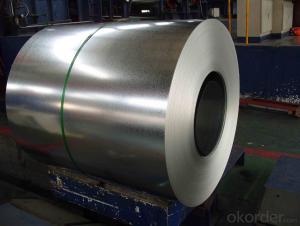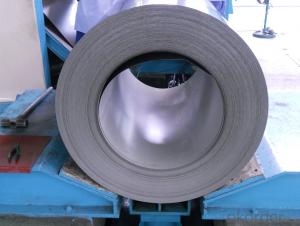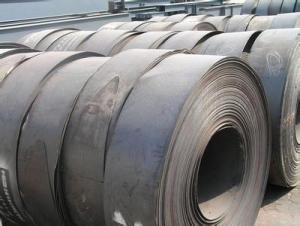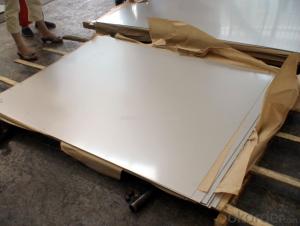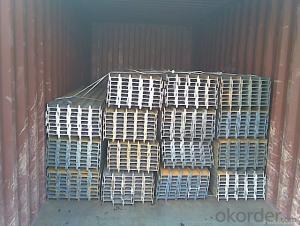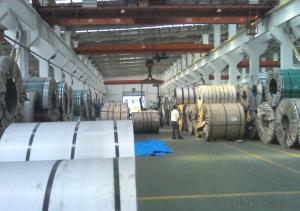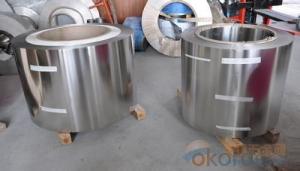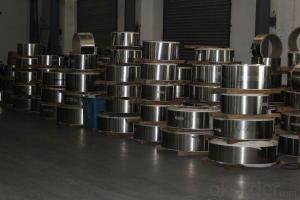Galvanized Steel Coil/Hot Dipped Galvanized Steel Strips Coil
- Loading Port:
- Tianjin
- Payment Terms:
- TT OR LC
- Min Order Qty:
- 1000 m.t.
- Supply Capability:
- 100000 m.t./month
OKorder Service Pledge
OKorder Financial Service
You Might Also Like
Galvanized Steel Coil/Hot Dipped Galvanized Steel Strips Coil Description:
Galvanized steel coil are widely used in the construction industry, as raw material for the production of corrugated panels, fencing products, drywall panel profiles, ventilation systems etc. Recommended for both outside and inside usage, galvanized steel has a high resistance to corrosion in different environments, due to a protective layer of zinc of 100 – 180 grams per square metre.
Main Features of Galvanized Steel Coil/Hot Dipped Galvanized Steel Strips Coil:
Hotdip galvanized steel coils are produced by immersing steel in a zinc bath. An appropriate galvanizing process requires a pretreatment process during which the steel passes through different baths which prepare the surface for zinc coating. In this stage, chemicals are used to clean the surface of the steel. After the chemical treatment, the steel coils pass through a bath of melted zinc at temperatures around 460 ° C. The resulting uniform coating is finished through a process of skin-passing to provide smooth and shiny appearance of the finished product. To store for a longer period, the hot-dip galvanized coils can be delivered with a final oil coating, according to the customer’s demand.
Galvanized Steel Coil/Hot Dipped Galvanized Steel Strips Coil Images:
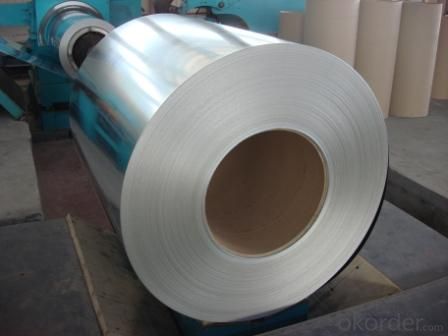
Galvanized Steel Coil/Hot Dipped Galvanized Steel Strips Coil Specifications:
Steel strips coils galvanized
Material: Q195, Q215, Q235, Q345B, SGCC, DX51D+Z
Thickness:0.75-4.5mm
Width:32-750mm
Zinc coating: 60-550g/m2
ITEM | |
Production | prime hot dipped galvanized steel strip coil |
Port | Tianjin, China |
Category | Minerals & metallurgy |
Thickness | 0.17-3.0mm |
Width | 600-1950mm |
Material Grade | SGCC,SGCH,SGCD1-SGCD3,DX51D |
Spangle | normal spangle, large spangle, small(min) spangle, zero spangle |
Technique | cold rolled,hot dipped galvanized |
Standard | ASTM,GB ,AISI,JIS,EN |
Test | With Hydraulic Testing, Eddy Current , Infrared Test |
Application | Widely used for roofs, outer walls, ovens, explosive-proof steel, electrically controlled cabinets,galvanized tube/pipe, ceiling channel, building material |
Surface | Galvanized |
Package | covered with waterproof-paper,strapped by strips. Or as customer’s requirement |
Sample | Common products, we can provide freely, for special production,we can depends on negotiation. |
MOQ | 5 tons |
Payment | 100% L/C at sight, 30% T/T in advance, and the balance against the copy of B/L or negotiation |
Delivery time | Within 10-25 days, according to quantity, asap save customer’s time |
Certificate | ISO9001:2008 |
FAQ:
Q: Are you manufacturer of trading company?
A: Yes.
- Q: What are the factors that affect the hardness of steel strips?
- There are several factors that can affect the hardness of steel strips. 1. Carbon content: The carbon content of steel plays a significant role in determining its hardness. Higher carbon content generally leads to increased hardness. 2. Alloying elements: The presence of certain alloying elements such as chromium, manganese, and molybdenum can also impact the hardness of steel strips. These elements can form carbides and increase the overall hardness of the material. 3. Heat treatment: The heat treatment process, including quenching and tempering, can greatly influence the hardness of steel strips. Quenching involves rapid cooling of the material, while tempering is a subsequent heating process that helps to increase toughness and reduce brittleness. 4. Cooling rate: The rate at which the steel strip is cooled during the manufacturing process can affect its hardness. Rapid cooling, such as through water quenching, can result in a harder material compared to slower cooling methods. 5. Grain size: The size of the grains within the steel structure can impact its hardness. Smaller grain sizes generally lead to increased hardness due to a more uniform distribution of carbon and alloying elements. 6. Impurities: The presence of impurities, such as sulfur and phosphorous, can negatively affect the hardness of steel strips. These impurities can form brittle compounds and reduce the overall hardness of the material. 7. Cold working: Cold working, such as rolling or drawing, can increase the hardness of steel strips. This process deforms the material and introduces dislocations, which in turn increase the strength and hardness. 8. Composition and microstructure: The composition and microstructure of the steel, including the presence of phases such as martensite, ferrite, and pearlite, can influence its hardness. These phases form during cooling and can contribute to different levels of hardness. It is important to note that the hardness of steel strips is often a trade-off with other properties such as toughness and ductility. Therefore, finding the right balance between hardness and other desired characteristics is crucial for specific applications.
- Q: What are the common industry standards for steel strips?
- The common industry standards for steel strips vary depending on the specific application and usage. However, there are several widely recognized standards that are commonly followed in the steel industry. One of the most prominent standards is the American Society for Testing and Materials (ASTM) standard. ASTM A109/A109M is the standard specification for steel, strip, carbon (0.25 maximum percent), cold-rolled. This standard provides guidelines for the chemical composition, mechanical properties, and dimensional tolerances of steel strips. Another widely used standard is the International Organization for Standardization (ISO) standard. ISO 9445 is the standard specification for continuous hot-rolled steel strip and plate. This standard covers the requirements for dimensions, surface quality, and mechanical properties of hot-rolled steel strips. In addition to these standards, there are various regional standards that are followed in specific areas. For example, in Europe, the European Committee for Standardization (CEN) has developed the EN 10139 standard, which specifies the requirements for cold-rolled narrow steel strip. Furthermore, industries such as automotive, construction, and manufacturing often have their own specific standards and requirements for steel strips. These standards are typically developed by industry associations or regulatory bodies to ensure the safety, quality, and performance of steel strips in their respective applications. Overall, while there are several common industry standards for steel strips, it is important for manufacturers, suppliers, and end-users to consult the specific standard applicable to their region and application to ensure compliance and meet the required specifications.
- Q: What are the common surface coating options for steel strips?
- Steel strips have a variety of surface coating options available to enhance their durability, corrosion resistance, and aesthetic appeal. Some commonly used options include: 1. Zinc Coating: Zinc coating, also known as galvanizing, is widely used to provide excellent corrosion resistance. It creates a protective barrier between the steel and the environment and can be applied through hot-dip galvanizing or electroplating. 2. Paint Coating: Paint coating adds aesthetic appeal and protects against corrosion and environmental damage. Techniques such as spray painting, powder coating, or coil coating can be used. 3. Organic Coatings: Organic coatings like polyurethane, epoxy, or acrylic provide additional protection against chemicals, abrasion, and weathering. They are often applied as a topcoat over a primer for optimal performance. 4. Phosphating: Phosphating involves applying a phosphate coating on steel strips. This enhances adhesion of subsequent coatings or paints and provides corrosion resistance. 5. Chromate Conversion Coating: Chromate conversion coating, or chromating, protects steel strips from corrosion. The steel is dipped in a solution containing chromate salts, forming a thin barrier layer. It is crucial to choose the appropriate surface coating option based on specific requirements such as intended application, environmental conditions, and desired performance characteristics. Factors like cost, durability, and maintenance requirements should be considered when making a choice.
- Q: Can steel strips be used in electrical conductors?
- Yes, steel strips can be used in electrical conductors, although they are not as commonly used as materials like copper or aluminum due to their higher resistance and lower conductivity. Steel strips may be used in certain applications where cost or mechanical strength is prioritized over electrical performance.
- Q: What are the common uses of steel strips?
- Steel strips have a wide range of common uses, including packaging, construction, automotive manufacturing, electrical appliances, machinery, and the production of various consumer goods.
- Q: How do steel strips contribute to reducing product weight in various applications?
- Steel strips contribute to reducing product weight in various applications through their unique properties and characteristics. Firstly, steel strips are known for their high strength-to-weight ratio. This means that they provide exceptional strength and stiffness while being relatively lightweight. By using steel strips in the manufacturing of products, designers and engineers can achieve the desired strength and performance while minimizing the overall weight of the finished product. This is particularly advantageous in industries where weight reduction is crucial, such as the automotive and aerospace sectors. Furthermore, steel strips can be produced in thin gauges, allowing for the creation of lightweight components. Thin steel strips can be easily formed, bent, and shaped into complex designs, offering versatility and flexibility in product design. This enables manufacturers to reduce the weight of their products by using thinner steel strips without compromising on structural integrity or quality. In addition, steel strips can be tailored to have specific mechanical properties through various manufacturing processes. For instance, advanced heat treatment techniques can be applied to increase the strength of steel strips, allowing for the use of thinner strips while maintaining the required load-bearing capacity. This customization capability enables engineers to optimize the weight of products by selecting the most suitable steel strip with the desired properties. Moreover, steel strips can be combined with other lightweight materials, such as composites, to create hybrid structures. By incorporating steel strips into composite materials, manufacturers can take advantage of the high strength of steel while benefiting from the lightweight properties of composites. This combination can result in significant weight reduction in applications such as construction, transportation, and renewable energy. Lastly, steel strips are highly recyclable and have a long lifespan, making them a sustainable choice for weight reduction. Steel can be recycled repeatedly without losing its properties, reducing the need for virgin materials and minimizing the environmental impact. The longevity of steel strips also ensures that products made with steel strips can withstand the test of time, reducing the need for frequent replacements and contributing to overall weight reduction. In conclusion, steel strips contribute to reducing product weight in various applications through their high strength-to-weight ratio, ability to be produced in thin gauges, customization capabilities, compatibility with lightweight materials, and recyclability. By incorporating steel strips into product design, manufacturers can achieve weight reduction without compromising on performance, making them an essential component in many industries.
- Q: Are steel strips suitable for the manufacturing of industrial pumps?
- Yes, steel strips are suitable for the manufacturing of industrial pumps. Steel is a strong and durable material that can withstand the high pressures and rigorous conditions typically encountered in industrial pump applications. Additionally, steel strips can be easily formed and shaped to meet the specific requirements of the pump design.
- Q: What are the characteristics of cold rolled strip technology?
- Cold rolled blank because the surface covered with oxide film and a small amount of impurities, will directly affect the precision of rolling and the quality of the product, so the blank material must first sent to the shallow groove company push-pull continuous pickling, pickling of oxide film and annealing to remove impurities, can be sent to the high precision six roller reversible rolling mill made the required thickness. After rolling through forced circulation cover type bright annealing furnace and high precision leveling unit two Kun to soften and smooth surface, and then finished packing or according to customer demand straight points, finally packaging factory.
- Q: Can steel strips be used for making springs in automotive suspension systems?
- Yes, steel strips can be used for making springs in automotive suspension systems. Steel is a commonly used material for springs due to its strength, durability, and ability to withstand heavy loads. Steel strips can be manufactured into various types of springs, including coil springs and leaf springs, which are commonly used in automotive suspension systems. These springs help absorb shocks and vibrations, providing a smooth and stable ride for the vehicle. Steel strips can be heat-treated and shaped into the desired form to meet the specific requirements of the suspension system, ensuring optimal performance and longevity. Moreover, steel strips are readily available, cost-effective, and widely used in the automotive industry, making them an ideal choice for making springs in automotive suspension systems.
- Q: How are steel strips processed for surface slitting?
- Steel strips are processed for surface slitting by first unwinding the coil and feeding it through a slitting machine. The machine has circular blades that cut the steel strip into narrower widths. The slitted strips are then rewound into separate coils according to the desired width. This process allows for precise and efficient cutting of steel strips for various applications.
Send your message to us
Galvanized Steel Coil/Hot Dipped Galvanized Steel Strips Coil
- Loading Port:
- Tianjin
- Payment Terms:
- TT OR LC
- Min Order Qty:
- 1000 m.t.
- Supply Capability:
- 100000 m.t./month
OKorder Service Pledge
OKorder Financial Service
Similar products
Hot products
Hot Searches
Related keywords













